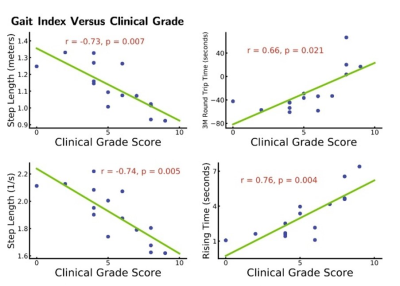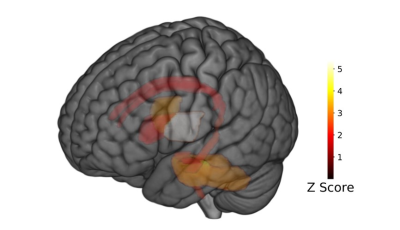shuai xu1, ye yao2, jing ding3, and he wang*4,5
1Fudan University, Shanghai, China, 2School of Public Health, Fudan University, Shanghai, China, 3Department of Neurology, Zhongshan Hospital, Fudan University, Shanghai, China, 4Institute of Science and Technology for Brain-Inspired Intelligence, Fudan University, Shanghai, China, 5Human Phenome Institute, Fudan University, shanghai, China
Synopsis
Grouping
based on white matter hyperactivities (WMH) of each white matter tract, 15 idiopathic
normal pressure hydrocephalus (iNPH) patients’ 10 gait index were compared by
double sample t test. The results showed some white matter tracts with
strongest gait index relationships located in motor and sensory pathways
including middle cerebellar peduncle (MCP), left medial lemniscus, left
posterior limb of internal capsule and right posterior limb of internal capsule.
Introduction
Idiopathic
normal pressure hydrocephalus
(iNPH) is a common hydrocephalus in the elderly adults. The iNPH patients are
usually characterized by progressive gait impairment, cognitive deficits and
urinary urgency and/or incontinence1. More radiographic studies manifested iNPH
patients have enlarged ventricle and altered brain morphology, but few of study
focus on the relationships between changed brain structure and gait
dysfunctions due to iNPH. Thus, the aims of this study were to evaluate the
abnormalities of white matter (WM) correlated with gait impairment in iNPH
patients and to have a better understanding of its pathology.Materials and Methods
Fifteen
iNPH patients (5 females, 10 males) were enrolled in this study and each
patients’ demographic and gait index were collected, see table 1. The images
were acquired using T2-weight TSE sequence with the following parameters: TR=6000ms,
TE=93ms, slice thickness=3mm. First, we proformed correlation analysis between
demographic and gait index. Then, grouping based on white matter hyperactivities
(WMH, means white matter tract damage) extracted from different WM tracts (JHU
white matter tractography atlas), all ten gait index compared by double sample t
test and synthesized through Fisher's method.Result
Removing
effects of age, gender and illness duration, correlation analysis showed
negative correlation between step length(r=-0.73, p=0.007), pace(r=-0.74, p=0.005)
and clinical grade score and positive correlation between 3m round trip
time(r=0.66, p=0.021), rising time(r=0.76, p=0.004) and clinical grade score,
see figure 1. Based on WMH of every white matter tracts, gait index showed
significant differences (p<0.05/48, corrected by bonferroni) between fewer
WMH patients and more WMH in middle cerebellar peduncle (MCP), left medial
lemniscus, left posterior limb of internal capsule and right posterior limb of
internal capsule, see figure 2,3.Discussion and Conclude
As the disease progresses, iNPH patients represented severer gait
performance. The MCP, as the biggest afferent fiber of cerebellum, receives
information from contralateral motor cortex. The posterior limb of internal
capsule is located in the motor conduction pathway as part of corticospinal
tract (CST) whose damage may cause motor dysfunction. Meanwhile, the medial colliculus
is the proprioceptive ascending pathway of the extremities that serves as processing
of sensory information. Therefore, these white matter tracts damage may have an
important role at abnormal gait of iNPH.Acknowledgements
This work was supported by Shanghai Municipal Science and Technology Major Project (No.2017SHZDZX01), Shanghai Municipal Science and Technology Major Project (No.2018SHZDZX01) and ZJLab, Shanghai Natural Science Foundation (No. 17ZR1401600) and the National Natural Science Foundation of China (No. 81971583).References
Adams RD, Fisher CM, Hakim S, Ojemann RG, Sweet
WH. Symptomatic Occult Hydrocephalus with "Normal"
Cerebrospinal-Fluid Pressure.A Treatable Syndrome. N Engl J Med
1965;273:117-126.



